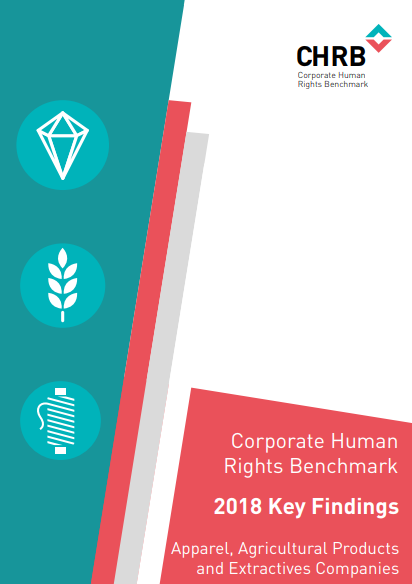Corporate Human Rights Benchmark: Pilot Methodology 2016
The CHRB pilot methodology assessed the top 100 companies across the agricultural products, apparel and extractives industries on their human rights policies, processes and performance.
The 2018 Corporate Human Rights Benchmark assesses 101 of the largest publicly traded companies in the world on a set of human rights indicators. The companies from 3 industries – Agricultural Products, Apparel, and Extractives – were chosen for the first Benchmark on the basis of their size (market capitalisation) and revenues and assessed across 6 Measurement Themes which have different weightings. Even though average scores are low across the board, overall companies tend to perform more strongly on policy commitments and management systems than on remedy or dealing with key risks in practice.

Average scores per region (source: CHRB 2018)
Some key takeaways from the results

The CHRB pilot methodology assessed the top 100 companies across the agricultural products, apparel and extractives industries on their human rights policies, processes and performance.
This Benchmark focuses on 98 companies of the three industries: Agricultural Products, Apparel, and Extractive. It is grounded in the UN Guiding Principles on Business and Human Rights, as well as additional standards and guidance focused on specific industries and...
The global population of forcibly displaced increased by 2.3 million people in 2018. By the end of the year, almost 70.8 million individuals were forcibly displaced worldwide as a result of persecution, conflict, violence, or human rights violations...Read More
This report considers how effectively the Action Plan to Tackle Trafficking in Persons and to Enhance Protection of Foreign Domestic Helpers in Hong Kong (the Action Plan) 1 has been implemented and, specifically, whether it has helped trafficked pe...Read More
The data in this report represents signals and cases from January 1, 2019 through December 31, 2019 and is accurate as of July 30, 2020. Cases of trafficking may be ongoing or new information may revealed to the National Hotline over time. Consequen...Read More
Expo 2020 Dubai could not have taken place without migrant workers who make up more than 90% of private sector employees in the UAE. With more than 40,000 workers employed in the construction process alone. Similarly, the delivery of the Expo requir...Read More